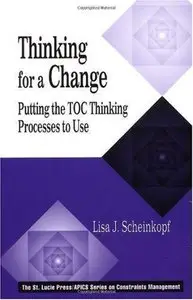Thinking for a Change: Putting the TOC Thinking Processes to Use by Lisa J . Scheinkopf
English | 1999 | ISBN: 1574441019 | 241 pages | PDF | 4 MB
English | 1999 | ISBN: 1574441019 | 241 pages | PDF | 4 MB
The book is about of the constraint-based perspective on systems and organizations, commonly referred to as the theory of constraints or synchronous management. The total benefit is not just to apply the thinking process, but to develop intuition and have the ability to combine logic and intuition in the same thinking process.
The first section will guide you through the fundamental principles and processes that are the backbone of the thinking process application tools.
The second section contains the step-by-step guidelines for each of the five thinking process application tools. These tools utilize sufficient cause thinking and necessary condition thinking.
Third section introduces two ways that two or more of the thinking process application tools are combined, providing robust processes for the understanding and communicating problems and solutions.This book can be used as a field guide to learning the five thinking process application tools as needed, based on their own particular issues. You will have a full understanding of the theory and practical application of these powerful processes, including when and when not to use each tool.
Contents
Introduction
PART ONE
Part One provides an overview of the constraint-based perspective on systems and organizations, commonly referred to as the theory of constraints or synchronous management. Chapters 3 through 5 will guide you through the fundamental principles and processes that are the backbone of the thinking process application tools.
1 The Theory of Constraints
2 First Steps
3 Sufficient Cause: Ef fect–Cause–Ef fect
4 The Categories of Legitimate Reservation
5 Necessary Condition Thinking
PART TWO
Part Two contains the step-by-step guidelines for each of the five thinking process application tools. Chapters 6, 7, and 8 are the tools that utilize sufficient cause thinking. Chapters 9 and 10 describe the tools that utilize necessary condition thinking.
6 Transition Tree
7 Future Reality Tree
8 Current Reality Tree
9 Evaporating Clouds
10 Prerequisite Tree
PART THREE
Introduces to two ways that two or more of the thinking process application tools are combined, providing robust processes for understanding and communicating problems and solutions.
11 The Full Analysis
12 Communication Curr ent Reality Tree
Closing Comments
Appendix



